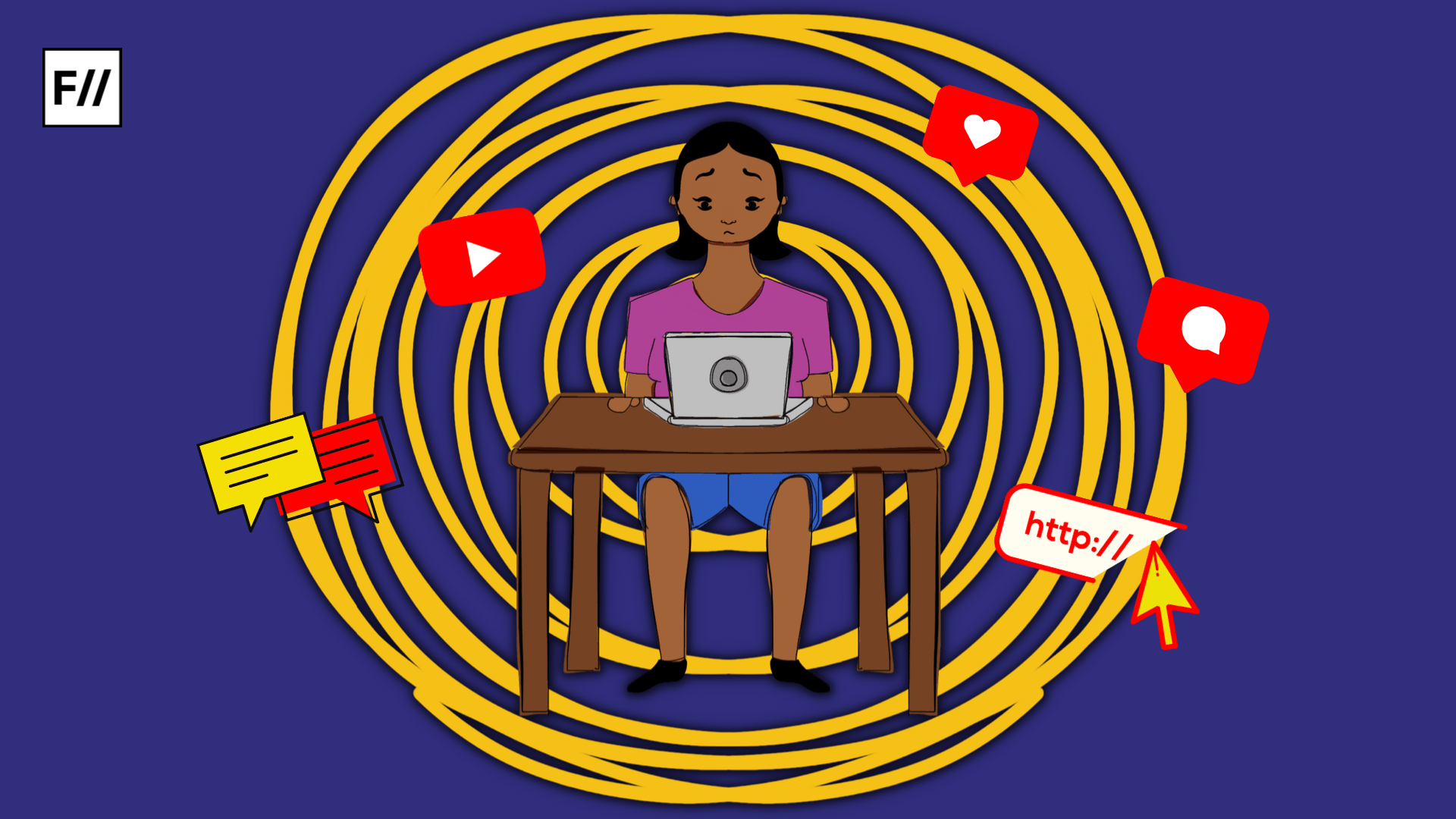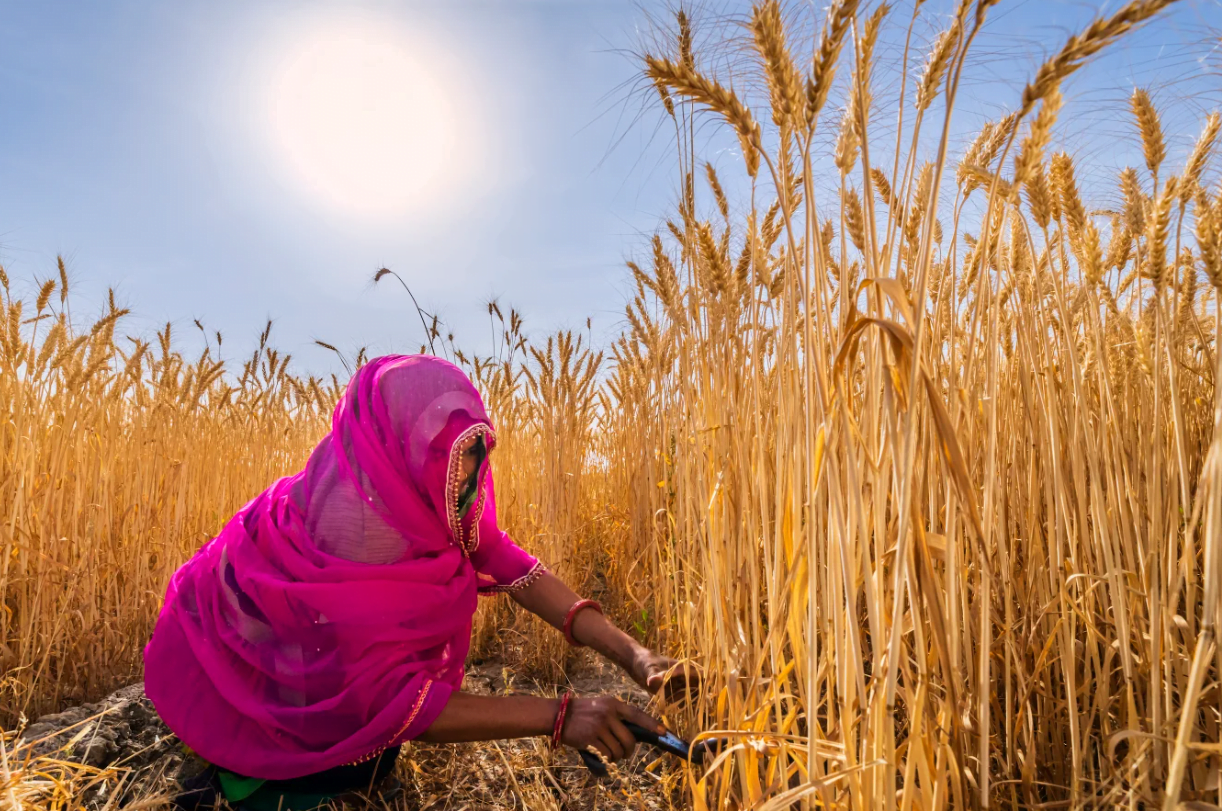Trigger Warning: Mentions of r*pe, sexual references, violence, death, self-objectification, self-sexualisation
The entertainment industry in India holds a pivotal position in instilling and resurfacing ideas, stereotypes, progressive ideologies and emotional drama to the public. The consumption of online media and OTT platforms has skyrocketed after internet plans and smartphones were made accessible to all.
Interestingly, a village in Rampurhat in West Bengal that reported political murders of villagers in 2022 did not have a lot of basic amenities, but most had access to internet, entertainment and connectivity applications such as Facebook, Tiktok, Instagram and Moj.
It is worth noting that the user bases of all social media platforms have very similar social profiles. Its use is much more among men than women, among those who have a college degree, are young, dominant caste, and come from a relatively elite background. The following image explains the rise in usage from data collected in 2019.
Thus, the fact that social media and online entertainment play a humongous role in the lives of the common man cannot be shunned away. But why is this topic essential? The world is getting digital rapidly and what appears as isolated incidents, are products of prolonged historical oppression transitioning into a modernised form of online suppression, violence, bullying and trauma. This new digital hatemongering will result in a new-age patriarchal social oppression for women and other gender minorities.
Roasting culture in India
The introduction of roasting in India was brough into mainstream by Mumbai based comedy company AIB (All India Bakc**d). The footage of the roast was released on YouTube, a free video streaming platform in 2015, and quickly became a hot topic for spreading “vulgarity” amongst young people as it roasted Bollywood celebrities such as Arjun Kapoor, Ranveer Singh and Karan Johar.
Over time, roasting has been accepted as a unique genre of comedy by other content creators. It quickly peaked with the release of a short five-minute clip uploaded by then 10-year-old YouTuber Ajey Nagar, also known as Carryminati. In 2021, creators are rapidly entering and migrating to this genre. This surge in the community has also led to increased repulsion and multiple reports of “unpleasant” humour. The question that arises is why does this community continue to thrive and attract more viewers?
In recent times, the roast culture has extended to engulf women and their existence on entertainment apps. Roasters have gone ahead to even term their dance as ‘ashleelta ki nagri’ (a colony of vulgarity) because of their dresses and dance moves. They are considered to be provocative and immoral that deserve lustful, sexually objectifying and threatful comments. In a way, they stick to the age-old stereotype of ‘men will be men’ and ‘the girl was asking for it’.
Viewers have considerable power to make these videos viral on the platform. It doesn’t matter if you like or hate the video. There is a very polarised approach, especially when looking at the work of mainstream trend creators. Jagjyot Singh, a popular comedian explains: “In a country where Big Boss has been around for 15 seasons, I really enjoy the drama. It’s a kind of sinful joy.”
This is a good explanation for why certain creators are aware of choosing the side. Due to this fixed bias, these roasts will select and investigate the problem from a very superficial point of view, such as appearance, class, and gender. In July 2020, four Indian YouTubers were arrested for threatening to violently r*pe a female comedian Agrima Joshua, based on a year old stand-up comedy video of her’s where she took a jibe at a proposed million statue of Chhatrapati Shivaji. Joshua’s video made her a target for hyper-nationalists and prompted threats that forced her to apologise.

The arrests highlighted a new genre of social media content: ‘selfie’ videos shot by nationalistic social media influencers, usually young men, often in their cars, delivering rants laced with expletives and violent threats. They have followings of lakhs and millions, and a list of targets that ranges from influencers in Pakistan to rival right-wingers to critics of the government. But their favourite targets are women, and their abuse-filled rants are full of threats of harassment and sexual violence.
In June, Vikas Phatak aka Hindustani Bhau spewed an expletive-laden rant at an Indian film producer, Ekta Kapoor, threatening her and her mother with sexual violence, objecting to a web series produced by her showing the wife of an Indian army officer having an extra-marital affair. In one of his videos, he said that Kapoor should thank the Army for guarding the borders or else she would not be able to “roam around in her skimpy clothes.”
What is the most surprising part of these incidents is that both Phatak and Mishra are awarded by Youtube with Creators Awards, although their hatemongering violates community guidelines.
We are all quite aware of how 2020 and 2021 turned out for Muslim women when apps like Sulli deals and Bulli Bai were created to auction women. These were women who created a niche for themselves in politics, journalism, literature, social work and so on but received threats, abuses and humiliation for their gender and religious identities.
It would not be wrong to say that hatemongering and digital bullying are at an all-time high. The audience for these messages of hate is overwhelmingly male, and the audience for such influencers is even more male-dominated.
Also read: ‘Bulli Bai’ And The Gendered Layers Of The Objectification Of Muslim Women

In recent times, the roast culture has extended to engulf women and their existence on entertainment apps. Roasters have gone ahead to even term their dance as ‘ashleelta ki nagri’ (a colony of vulgarity) because of their dresses and dance moves. They are considered to be provocative and immoral that deserve lustful, sexually objectifying and threatful comments. In a way, they stick to the age-old stereotype of ‘men will be men’ and ‘the girl was asking for it’.
With the influencer market for branded and platform deals projects a whopping $28 billion by 2026, a major driver of success is coming from platforms like Instagram, TikTok, Facebook, YouTube, and Twitch. The growth of Instagram reels, Facebook reels, Tiktok, Moj and OnlyFans (application for sharing sexual/non-sexual consented pictures in exchange for money) is proof of how the content is heavily consumed.
The illusion of autonomy is provided by social media. Once a decision is made, it remains online indefinitely. Autonomy is then stolen, as the picture no longer belongs to the poster, it belongs to the internet. Social media is a recognition of how patriarchy and caste bias operate in our modern society. In social media, patriarchy maintains relevance by demonstrating the objectification of women for pleasure and entertainment. It becomes clearly misogynistic when patterns related to gender are apparent.
Society thrives on these expressions of women, as seen in Bollywood item numbers or movies, but when a woman takes autonomy of her own body and chooses to make herself and her body available to the media, it comes under scrutiny and is more often abused. It is appalling how the content is desired in a sexual way but despised in a moral way. The roasting videos are followed by reaction videos which further stigmatise the position of women on social media. There is a duel between self-expression and conforming to a coveted sexual disposition.
According to a new survey, women on Instagram are subjected to an “epidemic of misogynist abuse.” The Center for Countering Digital Hate (CCDH), a nonprofit organisation dedicated to combating online hate and disinformation, collaborated with five high-profile women, including actress Amber Heard, to examine over 8,717 direct messages they received. The research accuses Instagram of ignoring allegations of abuse and the basic difficulties that these women on the site have while using the network’s safety tools.
Despite the messages being reported to moderators, the CCDH discovered that Instagram did not act on 90 per cent of the abuse delivered via direct message to the women in this study. When women with privilege face such systemic digital barriers, it is needless to say what individuals from other oppressed caste and gender locations undergo on a daily basis.

The rise of Instagram reflects an increasingly visual culture. But Instagram is not just a place for personal photography, it is a big business. This platform is the birthplace and breeding ground of influencer marketing. Women’s self-sexualisation and belonging may be inextricably connected. Self-sexualisation, or intentionally engaging in activities to appear sexually appealing to others, may carry intrapersonal costs.
Integrating objectification, belonging, and ostracism theories, it needs to be tested whether social exclusion increases women’s self-sexualisation and whether self-sexualisation reduces anticipated social exclusion. It is equally misogynistic to assume that women cannot handle their autonomy and need to be protected. The sentiment that women should only post images that do not exhibit their bodies is insensibly sexist.
The illusion of autonomy is provided by social media. Once a decision is made, it remains online indefinitely. Autonomy is then stolen, as the picture no longer belongs to the poster, it belongs to the internet. Social media is a recognition of how patriarchy and caste bias operate in our modern society. In social media, patriarchy maintains relevance by demonstrating the objectification of women for pleasure and entertainment. It becomes clearly misogynistic when patterns related to gender are apparent.
Roasting culture is one of the major manifestations of the growing ostracism of digital expression, especially against women, caste and gender minorities, which needs to be regulated and discussed to prevent heinous cyber crimes and physical acts of violence.
Also read: Freedom Of Expression Or Medium For Violence?: The Dignity Of Women In Cyber Discourses
Ankita Kundu is pursuing Masters in Women’s Studies from the Tata Institute of Social Sciences, Mumbai. She writes poetry and paints in her free time. Her areas of interest include women’s rights, sexuality and socio-economic conditions, art and representation of women.
Featured Illustration: Ritika Banerjee for Feminism In India




